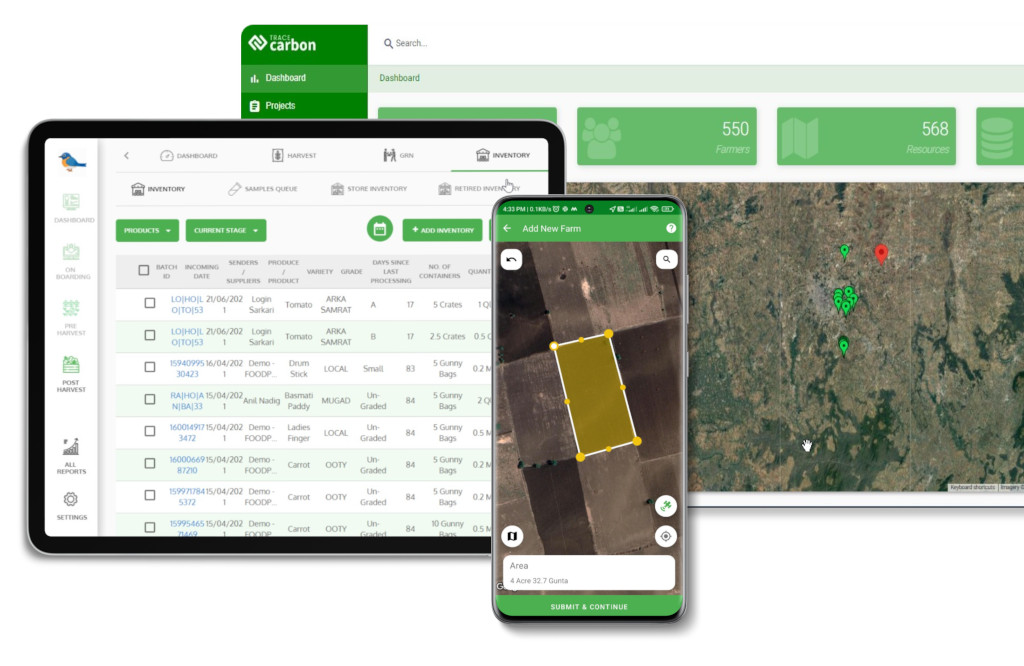Contact: +91 99725 24322 |
Menu
Menu
Quick summary: Explore the Intersection of Supply Chain Traceability and Ethical Practices in our insightful blog. Delve into the transformative impact of transparency on fostering ethical sourcing and responsible supply chains. Uncover the key to a sustainable and accountable business model. Read now for a deep dive into the heart of responsible supply chain management.

Transparency is the backbone of ethical sourcing because it enables verifiable accountability across the supply chain. Without traceable data on sourcing, labor, and environmental impact, companies cannot prove compliance with regulations like EUDR or meet rising consumer and investor expectations. Transparency transforms ethical claims into auditable, credible action.
A recent survey by Accenture Strategy revealed that a significant majority of consumers (62%) expect companies to actively address issues like sustainability, transparency, and fair labor practices. This demonstrates a growing demand for businesses to take a stand on socially and environmentally relevant matters.
Most companies claim sustainability, but lack proof of where their products come from, how they were produced, or who was impacted along the way. That’s a growing risk in a world where regulators, buyers, and consumers demand hard evidence—not vague commitments.
Whether it’s ensuring deforestation-free sourcing under EUDR or verifying labor rights across borders, the real challenge isn’t knowing what’s ethical—it’s proving it. And without real-time, verifiable data from farm to shelf, even the most well-intentioned brands are vulnerable to non-compliance, reputational damage, and blocked market access.
That’s where digital traceability comes in. By mapping suppliers, validating land use, and tracking certifications in one secure system, you turn transparency from a buzzword into a business advantage. With the right tools, you don’t just say you’re ethical—you can show it. Instantly. And at scale. In this guide, we’ll break down why transparency is essential for ethical sourcing—and how digital platforms make it achievable.
Key Takeaways
Ethical sourcing only works when it’s backed by transparency—clear, verifiable data on where, how, and by whom products are made. Without it, supply chains face hidden risks like deforestation, unfair labor, or expired certifications that can trigger regulatory penalties and erode trust.
Digital tools like TraceX enable this at scale with features like polygon-level geolocation, document validation, risk scoring, and audit-ready records. TraceX empowers brands to source responsibly, comply confidently, and build sustainable, trustworthy supply chains from the ground up.
When we talk about transparency in ethical sourcing, we’re talking about more than glossy CSR claims. True transparency means you can trace every ingredient, component, and labor hour—from raw-material origin to final product—backed by data that auditors, regulators, and consumers can independently verify.
Supply-chain transparency is the real-time ability to see, track, and validate what happens at every node in your sourcing network.
Traditional sustainability reports are retrospective snapshots—they tell stakeholders what happened last year. Transparency, on the other hand, is continuous and traceable.
Pairing transparency with digital traceability tools converts scattered supplier PDFs and verbal assurances into a single, tamper-proof ledger. That shift turns ethics from a marketing exercise into a defensible, data-driven asset—one that de-risks compliance and differentiates your brand in crowded markets.

Claiming your products are “ethically sourced” is easy; proving it is hard. Without transparent, verifiable data flowing through the supply chain, even the most well-intentioned sourcing program can collapse under scrutiny. Below are the core reasons ethical sourcing initiatives break down when transparency is missing—and how that gap becomes a liability.
Ethical sourcing unravels when you can’t see what happens two or three tiers deep:
Opaque sourcing doesn’t just hurt forests or workers; it hits the brand and bottom line:
Transparency converts ethics from a PR cost center into a data asset. When every lot carries a verifiable trail, you can monetize trust—winning premium shelf space, top-tier buyers, and lower financing rates.
Want to dive deeper into building a transparent, compliant supply chain?
Supply Chain Visibility for Compliance: Why It Matters More Than Ever
Supply Chain Due Diligence: How to Stay Ahead of Global Regulations
Only a live, end-to-end traceability system can close the transparency gap:
With data flowing continuously, ethical sourcing shifts from reactive damage control to proactive risk management—and becomes a true competitive advantage.
Transparency transforms ethical sourcing from a marketing claim into a measurable proof point. When customers, buyers, and investors can trace a product’s journey in real time—down to the GPS polygon of the farm—trust becomes quantifiable. Here’s how that works in practice.
Modern buyers—whether individual shoppers or corporate procurement teams—want proof, not promises. They expect:
See How Custom Surveys Drive Real Sustainability Impact
Discover how agribusinesses are using TraceX to deploy tailored survey activities that capture field-level insights, validate sustainability claims, and engage suppliers—all in one platform.
Read the Full Case Study to learn how you can align your sourcing data with your sustainability goals.
Investors now bake transparency into every funding decision. They look for:
Building ethical, transparent supply chains at scale isn’t humanly possible with spreadsheets and email. To meet EUDR, ESG, and buyer expectations, companies need digital traceability tools that turn supplier data into live, verifiable insight—from the farm level to the audit file.
True farm-to-fork transparency means you can follow every ingredient from its point of origin to the consumer’s plate—validating sustainability claims, food-safety standards, and brand promises along the way. Powerful traceability platforms achieve this with five core capabilities:
Together, these features turn traceability software into a single source of sustainable truth—bridging the gap between responsible growers, conscious consumers, and every checkpoint in between.
Manual processes in farm-to-fork sourcing often rely on spreadsheets, paper records, email threads, and human interpretation—making them slow, error-prone, and hard to verify. These outdated workflows introduce blind spots that can jeopardize food safety, sustainability claims, and regulatory compliance.
Digital traceability systems eliminate these risks by automating, validating, and centralizing your entire supply chain footprint—from farm input to consumer product.
In sustainable sourcing, the real risk isn’t just fraud or non-compliance—it’s not knowing what you don’t know. Manual systems create blind spots that ethical claims can’t survive.
Digital traceability doesn’t just surface errors—it prevents them, replaces guesswork with structured data, and creates a chain of trust that’s traceable to the root.

TraceX is purpose-built to deliver farm-to-fork digital traceability, eliminating the fragmentation and guesswork that plague traditional supply chains. Whether you’re navigating EUDR compliance, organic certification, or simply building a trustworthy brand, TraceX automates the heavy lifting and brings full transparency into view.
TraceX captures polygon-level farm boundaries—not just GPS points—and cross-verifies them using satellite feeds (like Sentinel-2 or GLAD alerts). This ensures deforestation risks are flagged early and sourcing locations are always audit-ready.

Instead of scattered spreadsheets and email chains, TraceX gives you a unified dashboard where all supplier documents, geolocation files, certifications, and assessments live in one structured place—searchable, filterable, and export-ready.
Suppliers can upload land titles, organic certificates, and labor permits via a secure portal. TraceX uses AI-powered parsing to extract data fields and automatically alerts you before key documents expire—so nothing falls through the cracks.
With TraceX, operators can log and track payment terms, price points, and sales records at the producer level. This creates transparent proof of fair compensation across the supply chain—helping brands back up living income claims and reduce exploitation risk, especially for smallholders.
Every action—supplier update, document upload, or assessment—is logged, timestamped, and locked. This creates a digital compliance trail for audits and internal governance, eliminating the risks of human error or unverified claims.
TraceX helps identify child labor red flags by combining supplier profiling (location, crop, seasonality) with uploaded labor declarations and audit reports. High-risk profiles can be auto-flagged for additional review—ensuring your sourcing complies with labor laws and ethical standards.
Learn how leading agribusinesses use farmer profiling to detect high-risk zones, monitor labor practices, and ensure ethical sourcing at the ground level.
Read the Case Study to explore how TraceX empowers proactive compliance and responsible sourcing.
TraceX isn’t just a compliance tool. It’s a supply chain intelligence layer that transforms disconnected data into real-time, actionable transparency—empowering you to source responsibly, scale ethically, and win trust where it matters most.

Incorporating traceability into your supply chain isn’t just about meeting regulatory demands—it’s about committing to a higher standard of ethical practice. By enabling transparency and accountability, traceability allows you to track every step of your product’s journey, ensuring that your supply chain adheres to ethical standards and operates responsibly. This dedication not only enhances your brand’s credibility but also fosters trust with consumers, partners, and stakeholders. In a world where ethical practices are increasingly under scrutiny, investing in robust traceability systems is a proactive step towards a more sustainable and ethical future.
Transparency ensures that ethical sourcing claims—like fair labor, legal land use, or deforestation-free production—are backed by verifiable data. It builds trust, enables regulatory compliance, and helps identify risks hidden in complex supply chains.
Companies can achieve full supply chain visibility by using digital traceability platforms that capture geolocation, supplier documentation, risk scores, and real-time alerts across every tier—from origin to final product.
Traceability tracks the movement of goods and data across the supply chain, while transparency means making that information visible, verifiable, and accessible to stakeholders. Traceability is the foundation; transparency is the outcome.
